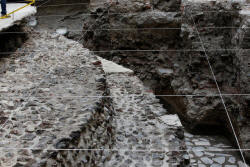|
 Archaeologists
discover Aztec ball court in heart of Mexico City Archaeologists
discover Aztec ball court in heart of Mexico City
 Send a link to a friend
Send a link to a friend
[June 08, 2017]
By David Alire Garcia
MEXICO CITY (Reuters) - The
remains of a major Aztec temple and a ceremonial ball
court have been discovered in downtown Mexico City,
shedding new light on the sacred spaces of the
metropolis that Spanish conquerors overran five
centuries ago, archaeologists said on Wednesday.
|
|
 The discoveries were made on a nondescript side street just
behind the city's colonial-era Roman Catholic cathedral off the
main Zocalo plaza on the grounds of a 1950s-era hotel. The discoveries were made on a nondescript side street just
behind the city's colonial-era Roman Catholic cathedral off the
main Zocalo plaza on the grounds of a 1950s-era hotel.
The underground excavations reveal a section of what was the
foundation of a massive, circular-shaped temple dedicated to the
Aztec wind god Ehecatl and a smaller part of a ritual ball
court, confirming accounts of the first Spanish chroniclers to
visit the Aztec imperial capital, Tenochtitlan.
"Due to finds like these, we can show actual locations, the
positioning and dimensions of each one of the structures first
described in the chronicles," said Diego Prieto, head of
Mexico's main anthropology and history institute.
Archaeologists also detailed a grisly offering of 32 severed
male neck vertebrae discovered in a pile just off the court.

"It was an offering associated with the ball game, just off the
stairway," said archaeologist Raul Barrera. "The vertebrae, or
necks, surely came from victims who were sacrificed or
decapitated."
Some of the original white stucco remains visible on parts of
the temple, built during the 1486-1502 reign of Aztec Emperor
Ahuizotl, predecessor of Moctezuma, who conquistador Hernan
Cortes toppled during the Spanish conquest of Mexico.
Early Spanish accounts relate how a young Moctezuma played
against an elderly allied king on the court and lost, which was
taken as sign that the Aztec Empire's days were numbered.
[to top of second column] |

The building would have stood out because of its round shape among
the several dozen other square temples that dominated the Aztecs'
most sacred ceremonial space before the 1521 conquest.
Aztec archaeologist Eduardo Matos said the top of the temple was
likely built to resemble a coiled snake, with priests entering
though a doorway made to look like a serpent's nose.
Once excavations finish, a museum will be built on the site, rubbing
shoulders with modern buildings in the capital.
Mexico City, including its many colonial-era structures with their
own protections, was built above the razed ruins of the Aztec
capital, and more discoveries are likely, Matos said.
"We've been working this area for nearly 40 years, and there's
always construction of some kind ... and so we take advantage of
that and get involved," he said.
(Editing by Dave Graham and Leslie Adler)
[© 2017 Thomson Reuters. All rights
reserved.] Copyright 2017 Reuters. All rights reserved. This material may not be published,
broadcast, rewritten or redistributed.
 |